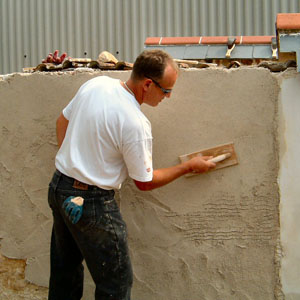Further info for Lime
Extra tips & tutorials

Lime plasters and renders
See ‘making lime mortars‘ for how to make mortars, plasters and renders.
What is building lime?
All types of building lime are made from limestone, which is a sedimentary rock composed of the dead bodies of sea creatures such as shellfish, corals and some planktons.
Different types of lime
Non-hydraulic lime (quicklime), hydrated lime, hydraulic lime and lime sand.
Environmental and health benefits of lime
Environmental and health benefits of lime.
Benefits of lime for buildings
Lime is not much good for tower blocks or supermarkets, as it doesn’t have the strength or speed required; but it’s ideal for the domestic scale,
Modern alternatives to lime
….. and why lime fell out of favour.
Health & safety
Quicklime is dangerous. It is extremely caustic, and can burn skin especially when wet. Eyes must be protected at all times.
Slaking lime
You may be interested in following the process through from beginning to end – although you may not want to burn your own limestone, you may want to slake quicklime.
Rendering straw-bale buildings
This section contains specific information for straw-bale buildings. It’s best to let the building settle for as long as possible after building, before you render it.
Lime slurry
Lime slurry can be applied to a wall to present a uniform surface to further coats of lime wash.
Lime wash
One part lime putty, c. two parts water or until the consistency of full cream milk is achieved. Mix in a small tub or a bucket with a whisk. You can sieve for a particularly fine finish.
Limecrete
Lime concrete, or limecrete, has been used since Roman times for massive structures such as bridges, docks, and even the dome of the pantheon in Rome.
